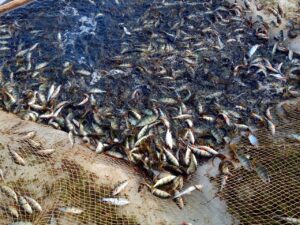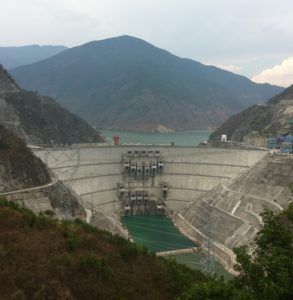Thank you for the opportunity to submit public comment on the value of digitizing the National Marine Fisheries Service (NMFS), National Oceanic and Atmospherics’ (NOAA) Certification of Admissibility form (COA), (NOAA-NMFS-2022-0057). The Stimson Center is a nonprofit, nonpartisan research institution based in Washington, DC that supports policy action to effectuate durable global change. Our Environmental Security Program has conducted extensive research and published reports on the security threats of Illegal Unreported and Unregulated (IUU) fishing and the importance of effective implementation of NOAA’s seafood trade monitoring programs.
Stimson would like to congratulate NOAA and NMFS on its movement to revise regulations concerning the Certification of Admissibility (COA) program related to entry of fish products subject to trade restrictions. By revising the import rules under the Marine Mammal Protection Act (MMPA) and High Seas Driftnet Fishing Moratorium Protection Act (Moratorium Protection Act) to digitize the Certificate of Admissibility, if done effectively as highlighted in our comments below, it will enable the government to improve the implementation of trade restrictions under the Moratorium Protection Act and the MMPA Imports rule. It will also help support industry by simplifying and making consistent the data entry filing for seafood imports, reduce inequitable and time-consuming burdens for data entry, and create a system that can work across federal and NMFS specific programs to identify information pertinent to all seafood entering the United States.
There are numerous seafood trade monitoring programs managed by NMFS which require different types of data to be filed into the Automated Commercialization Environment (ACE) system managed by the U.S. Customs and Border Protection (CBP) Agency. In addition to the Moratorium Protection Act and MMPA, other trade programs include the Tuna Tracking and Verification Program (TTVP), Highly Migratory Species Program (HMS), Antarctic Living Marine Resources Program (AMLR), and the Seafood Import Monitoring Program (SIMP). Because NMFS requires different information for each trade monitoring program, the current state of implementation when viewed collectively can be seen as inefficient, at times ineffective, resulting in a filing landscape that is time-consuming, confusing, and unfair to industry who are trying to abide by the seafood importation requirements. NMFS should consider addressing the burden on industry of inconsistent filing requirements from program-to-program. In addition, major opportunities exist for NMFS to improve its technology tool kit and take advantage of searchable, and interoperable technologies which would provide benefits across all of these trade programs by increasing data sharing, improve analysis and support consistent enforcement of the rules. To resolve and improve these issues rather than exacerbate the situation, the Stimson Center recommends that NMFS incorporate the following measures in the development of this proposed rule:
1. Harmonize COA entry requirements with the established Seafood Import Monitoring Program (SIMP) dataset and require it for all seafood.
Earlier this year, NMFS consolidated the administration of its seafood trade monitoring programs under the Office of International Affairs and Trade Commerce, with the goal of better serving industry through this reorganization1See https://www.fisheries.noaa.gov/feature-story/noaa-fisheries-announces-new-name-its-international-office.. Aligning the customs data collection efforts managed by this office is an excellent opportunity to serve this mission. Digitization of the COA will introduce new data reporting requirements for industry, but the burden of implementing these requirements would be eased if NMFS were to utilize consistent and comparable data requirements across all its trade monitoring programs such as the data elements required in the SIMP. These cover the greatest number of import data requirements, and it is a program the seafood industry has grown accustomed to using over the last five years. The table below illustrates the complexity of entry filing NMFS maintains across its trade monitoring programs and demonstrates how all these requirements could be met by applying the SIMP ACE message set to all seafood imports subject to trade monitoring by NMFS. Several data elements pertinent to the product’s harvest are not captured in the COA form. Without this consistent information it would make fishery-level enforcement of an import restriction very difficult if not impossible to detect.
Table: Variability in ACE message set across NMFS trade monitoring programs as compared to the Certification of Admissibility form.
| Data element | COA form | TTVP ACE message set | HMS ACE message set | AMLR ACE message set | SIMP ACE message set |
| Species | X | X (partial) | X (partial) | X | |
| Harvest Type | X | ||||
| Country Code | X | X | X | ||
| Harvest Location | X | X | X | ||
| Harvest Date | X | ||||
| Fishing Gear | X | X | X | ||
| Vessel information | X | X (limited) | X (limited) | X (name, flag, ID) | |
| Product Form at landing | X | X | |||
| Product Weight at landing | X | X | |||
| Signed Attestation (upload) | X | X | X | X |
It is important that NMFS consider the long-term viability of its mission to combat IUU fishing, seafood fraud, promote sustainable fisheries, and protect the domestic industry through fair and effective application of trade monitoring and restrictions in this rulemaking process. Executing on this mission will require raising the bar for data collection across all NMFS seafood trade programs to the common denominator of SIMP, which is the only program suited to fishery product-level trade monitoring at scale.
While a COA is currently required for a relatively small quantity of seafood imports from Mexico, it is anticipated that in the near term this information will also become mandatory for all seafood imports under the MMPA and Moratorium Protection Act to effectively enforce prohibitions under these regulations. With COA data included in customs entry filing, the government will be able to implement trade restrictions more effectively and efficiently than ever before. This data will be valuable to NMFS, but also to the government as a whole in its efforts to ban products sources from countries under US sanctions. For example, if this message set were applicable to all seafood today, the US would be able to ban imports of Russian-harvested seafood rather than only seafood exports directly from Russia, which represents a fraction of Russian seafood sold into the US.
While Stimson understands and appreciates that NMFS and CBP are still developing its capacity to collect, manage and analyze trade data efficiently and effectively, we see this as an opportunity to use existing and emerging technologies that allow critical datasets across the trade monitoring programs to be made interoperable in the new ACE system. The technology tool kit to trace imported seafood electronically has improved, and this rule provides an opportunity for NMFS to work with CBP and fully leverage technology innovation by organizing and requiring the digital information needed to perform basic enforcement functions.
2. Fully digitize entry filing in ACE.
Standardized electronic traceability will improve global compliance with the MMPA and the Moratorium Protection Act and minimize confusion across the industry caused by multiple programs that require different documentation and digitized information during entry filing. The notice of proposed rulemaking suggests that NOAA will propose only a partial digitization of the current COA paper form in addition to requiring submission of the scanned form as a digital upload in the customs entry filing system. Requiring a paper record that could instead be fully digitized seems redundant and burdensome to the importers and customs brokers. Industry and government are best served by fully digitized traceability systems. Unlike data, paper records are difficult to review in large volumes, easily falsified and damaged, and burdensome to maintain. NMFS should leverage this rulemaking to phase in the mandated use of standardized electronic catch documentation as a means to reduce the falsification of catch documentation records across its programs. At a minimum, this rulemaking should eliminate the requirement for paper records submission to NOAA as a part of the entry filing process and serve as a template for the digitization for other documentation in the near future.
3. Require affirmation of compliance with applicable labor laws and treaties.
The digitized COA will be used to implement import prohibitions under the Moratorium Protection Act, therefore understanding labor is important to screening entries. Inclusion of a labor compliance attestation would represent clear, actionable follow through on Administration policies and new initiatives. The Biden Administration has begun integrating fisheries trade regulations and labor under the Memorandum on Combating Illegal, Unreported, and Unregulated Fishing and Associated Labor Abuses (NMS-11), and NOAA has amended the definition of IUU fishing to include labor in the proposed Implementation of Provisions of the Illegal, Unreported, and Unregulated Fishing Enforcement Act of 2015 and the Ensuring Access to Pacific Fisheries Act (RIN 0648-BG11). NOAA’s new public-private initiative—the Collaborative Accelerator for Lawful Maritime Conditions in Seafood (CALM-CS) seeks to support implementation of best practices in labor across the seafood industry, and inclusion of a basic labor data element would be an excellent first concrete step down that path.
Efforts to identify data elements that could be used to detect risk of labor violations continues to evolve, but an initial step could easily be added to the COA by including an attestation that the seafood to be imported was harvested in accordance with applicable labor laws. The attestation itself could be a simple checkbox, but its presence will help elevate the issue of and accountability for responsible labor practices in fisheries with industry and provide a new resource for risk targeting and enforcement to NOAA and partner agencies. NMFS should also consider new data elements that would support implementation of the Moratorium Protection Act such that would identify transshipment, trip duration, proof of vessel tracking information and beneficial ownership of vessels.
The Stimson Center looks forward to continuing to work with NMFS on the development and implementation of seafood trade policies that protect the environment, and provide vital food security, economic security, and national security to coastal states around the world.
Very truly yours,

Sally Yozell
Director, Environmental Security Program
The Stimson Center
Notes
- 1See https://www.fisheries.noaa.gov/feature-story/noaa-fisheries-announces-new-name-its-international-office.



